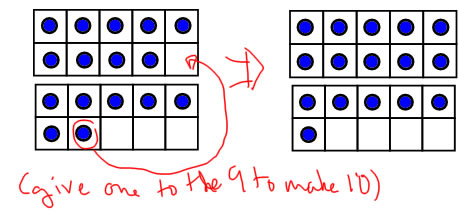
1. What do children need to know and be able to do before they can use the make 10 to add strategy?
2.Give two examples of good materials for learning partners that make 10.
10-frames and Rekenreks and fingers
3. Tell what good materials for learning partners that make 10 have in common.
They all show numbers in a way that they can be subitized, and which show the relationships to 5 and 10.
4. Which strategy name means the same as make 10 to add?
Bridge through 10
5. How is a Use 10 strategy different from a Make 10 strategy.
A use 10 strategy refers to using a sum you know is 10 to figure out sums of numbers very close to those. For instance, you might use your knowledge that 6+4=10 to figure out 6+3 or 6+5. In a use 10 strategy you are comparing to a sum you know is 10. The sum in these cases is always near 10, and is sometimes less than 10.
In a make 10 strategy, the sum is always greater than 10, and the strategy involves splitting (decomposing) one addend so that 10 can be made by joining a part with the other addend.
6. Describe in words how to use a Make 10 strategy to solve 9+7.
Split 7 into 1+6, and join the 1 to the 9 to make 10. The sum is now 10+6=16.
8. Illustrate using a 10-frame how to use a Make 10 strategy to solve 9+7.
9. Illustrate using an open number line how to use a Make 10 strategy to solve 9+7.
10. Trace Cuisenaire rods to show how to use a Make 10 strategy to solve 9+7.
11. For what addition facts is the make 10 strategy efficient?
Addition problems where one addend is 8 or 9 and the sum is more than 10.
12. Any addition word problem type would be appropriate (JRU, PPW-WU or CQU of the more...than type). The first addend should be 9, and the second addend should be 5, 6, 7or 8.